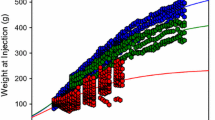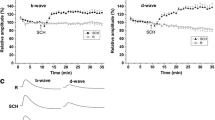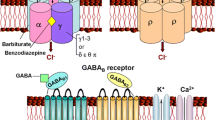Abstract
Background
The effects of GABA in the retina have now become of special interest because the anti-epileptic drug vigabatrin, a GABA analogue, can cause visual field loss in humans. Vigabatrin inhibits the GABA-aminotransferase, which finally results in GABA accumulation in the extracellular space. The b-wave of the electroretinogram (ERG), which originates partly in on-bipolar cells, is influenced by both GABAergic horizontal cells (HCs) and GABAergic amacrine cells (ACs). Their influences, however, are difficult to separate. In an attempt to isolate the effect of GABAergic ACs, use has been made of the specific effect of the GABA-uptake-blocker NO-711, which blocks only the GABA transporter GAT1 of GABAergic ACs.
Methods
The ERG and the intracellular responses of HCs to light were recorded in the isolated rabbit retina, and the effects of GABA and NO-711, when added separately to the superfusate, were determined.
Results
GABA reduced significantly both the light responses of HCs and the b-wave. NO-711 enlarged the b-wave drastically, but did not affect the responses of HCs to light.
Conclusions
An increase in the extracellular GABA concentration decreases the b-wave; an impairment of the function of ACs increases the b-wave. These conditions are discussed in the context of the lack of consistent changes to the b-wave during therapy with vigabatrin.






Similar content being viewed by others
References
Arnason A, Eysteinson T (1997) The role of GABA in modulating the Xenopus electroretinogram. Vis Neurosci 14:1143–1152
Awatramani G, Wang J, Slaughter MM (2001) Amacrine and ganglion cell contributions to the electroretinogram in amphibian retina. Vis Neurosci 18:147–156
Banin E, Shalev RS, Obolensky A, Neis R, Chowers I, Gross-Tsur V (2003) Retinal function abnormalities in patients treated with vigabatrin. Arch Ophthalmol 121:811–816
Besch D, Kurtenbach A, Apfelstedt-Sylla E, Sadowski B, Dennig D, Asenbauer C, Zrenner E, Schiefer U (2002) Visual field constriction and electrophysiological changes associated with vigabatrin. Doc Ophthalmol 104:151–170
Billups D, Attwell D (2002) Control of intracellular chlorid concentration and GABA response polarity in rat ON bipolar cells. J Physiol 54:183–198
Blanco R, Vaquero CF, de Villa P (1996) The effects of GABA and glycine on horizontal cells of the rabbit retina. Vision Res 36:3987–3996
Bormann, J (2000) The “ABC” of GABA receptors. TIPS 21:16–19
Comaish IF, Gorman C, Brimlow GM, Barber C, Orr GM, Galloway NR (2002) The effects of vigabatrin on electrophysiology and visual fields in epileptics: a controlled study with a discussion of possible mechanisms. Doc Ophthalmol 104:195–212
Coupland SG, Zackon DH, Leonard BC, Ross TM (2001) Vigabatrin effect on inner retinal function. Ophthalmology 108:1493–1496
Dong CJ, Werblin FS (1998) Temporal enhancement via GABAc feedback at bipolar terminals in the tiger salamander retina. J Neurophysiol 79:2171–2180
Dong CJ, Hare WA (2002) GABAc feedback pathway modulates the amplitude and kinetics of ERG b-wave in a mammalian retina in vivo. Vision Res 42:1081–1087
Eke T, Talbot JF, Lawden MC (1997) Severe persistent visual field constriction associated with vigabatrin. BMJ 314:180–181
Euler T, Wässle H (1998) Different contributions of GABAA and GABAC receptors to rod and cone bipolar cells in a rat retinal slice preparation. J Neurophysiol 79:1384–1395
Euler T, Masland RH (2000) Light-evoked responses of bipolar cells in a mammalian retina. J Neurophysiol 83:1817–1829
Flores-Herr N, Protti D, Wässle H (2001) Synaptic currents generating the inhibitory surround of ganglion cells in the mammalian retina. Neuroscience 21:4852–4863
Gottlob I, Wündsch L, Tuppy FK (1988) The rabbit electroretinogram: effect of GABA and its antagonists. Vision Res 28:203–210
Gurevich L, Slaughter MM (1993) Comparison of the waveform of the ON bipolar neuron and the b-wave of the electroretinogram. Vision Res 33:2431–2435
Hanitzsch R, Bornschein H (1965) Spezielle Überlebensbedingungen für isolierte Netzhäute verschiedener Warmblüter. Experientia 21:484
Hanitzsch R, Tomita T, Wagner H (1984) A chamber preserving cellular function of the isolated rabbit retina suited for extracellular and intracellular recording. Ophthalmic Res 16:27–30
Hanitzsch R, Lichtenberger T, Mättig W-U (1996) The influence of MgCl2 and APB on the light-induced potassium changes and the ERG b-wave of the isolated superfused rat retina. Vision Res 36:499–507
Hanitzsch R, Küppers L (2001) The influence of HEPES on light responses of rabbit horizontal cells. Vision Res 41:2165–2172
Hanitzsch R, Küppers L (2002) The effect of GABA and vigabatrin on horizontal cell responses to light and the effect of vigabatrin on the electroretinogram. Doc Ophthalmol 105:327–338
Harding GF, Wild JM, Robertson KA, Rietbrock S, Martinez C (2000) Separating the retinal electrophysiologic effects of vigabatrin. Treatment versus field loss. Neurology 55:347–352
Harding GF, Wild JM, Robertson KA, Lawden MC, Betts TA, Barber C, Barnes, PM (2000) Electro-oculography, electroretinography, visual evoked potentials, and multifocal electroretinography in patients with vigabatrin-attributed visual field constriction. Epilepsia 41:1420–1431
Harding GF, Robertson EL, Spencer EL, Holliday I (2002) Vigabatrin; its effects on the electrophysiology of vision. Doc Opthalmol 104:213–229
Hardus P, Verduin WM, Berendschott TT, Kamermans M, Postma G, Stilma JS, van Veelen CW (2001) The value of electrophysiology in patients with epilepsy and vigabatrin associated visual field loss. Acta Ophthalmol Scand 79:169–174
Haverkamp S, Grünert U, Wässle H (2000). The cone pedicle, a complex synapse in the retina. Neuron 27:85–95
Ichinose T, Lukasiewicz PD (2002) GABA transporters regulate inhibition in the retina by limiting GABA(C) receptor activation. J Neurosci 15:3285–3292
Johnson J, Chen TK, Rickman DW, Evans C, Brecha NC (1996) Multiple gamma-aminobutyric acid plasma membrane transporters (GAT-1, GAT-2, GAT-3) in the rat retina. J Comp Neurol 375:212–214
Kamermans M, Werblin F (1992) GABA-mediated positive autofeedback loop controls horizontal kinetics in tiger salamander. Neuroscience 12:2451–2463
Kapousta-Bruneau NV (2000) Opposite effects of GABA(A) and GABA(C) receptor antagonists on the b-wave of ERG recorded from the isolated rat retina. Vision Res 40:1653–1665
Karwoski CJ, Xu X (1999) Current source-density analysis of light-evoked field potentials in rabbit retina. Vis Neurosci 16:369–377
Lam DMK (1997) Neurotransmitters in the vertebrate retina. Invest Ophthalmol Vis Sci 38:553–556
Lichtenberger T, Karbaum R, Flade A, Hanitzsch R (2000) Low b-wave amplitudes in a strain of rabbits with a pigment epithelium defect. Vision Res 40:129–136
Marc RE, Liu W (2000) Fundamental GABAergic amacrine cell circuitries in the retina: nested feedback, concatenated inhibition, and axosomatic synapses. J Comp Neurol 425:560–582
McGillem GS, Rotolo TC, Dacheux RF (2000) GABA responses of rod bipolar cells in rabbit retinal slices. Vis Neurosci 17:381–389
Menger N, Wässle H (2000) Morphological and physiological properties of the A17 amacrine cell of the rat retina. Vis Neurosci 17:769–780
Naarendorp F, Sieving P (1991) The scotopic threshold response of the cat ERG is suppressed selectively by GABA and glycine. Vision Res 31:1–16
Naarendorp F, Hitchock PF, Sieving P (1993) Dopaminergic modulation of rod pathway signals does not affect the scotopic ERG of cat at dark-adapted threshold. J Neurophysiol 70:1681–1691
Neal MJ, Cunningham JR, Shah MA, Yazulla S (1989) Immunocytochemical evidence that vigabatrin in rats causes GABA accumulation in glial cells of the retina. Neurosci Lett 98:29–32
Nusinowitz S, Azimi A, Heckenlively JR (2000) Adaptation, body temperature, pupil size and anesthetic effects on the electroretinogram (ERG) in mice (abtsract no. 2634). Invest Ophthalmol Vis Sci 41:S495
Ponjavic V, Andreason S (2001) Mulitfocal ERG and full-field ERG in patients on long-term vigabatrin medication. Doc Ophthalmol 102:63–72
Pow DV, Rogers P (1996) GABA transaminase regulates neuronal glutamate content in the retina. Neuroreport 4:2683–2686
Pow DV, Baldridge W, Crook DK (1996) Activity-dependent transport of GABA analogues into specific cell types demonstrated at high resolution using a novel immunocytochemical strategy. Neuroscience 73:1129–1143
Robson JG, Frishman LJ (1995) Response linearity and kinetics of the cat retina: the bipolar cell component of the dark adapted electroretinogram. Vis Neurosci 12:837–850
Shields CD, Tran MN, Wong RO, Lukasiewicz PD (2000) Distinct ionotropic GABA receptors mediate presynaptic and postsynaptic inhibition in retinal bipolar cells. J Neurosci 20:2673–2682
Satoh H, Kaneda M, Kaneko A (2001) Intracellular chlorid concentration is higher in rod bipolar cells than in cone bipolar cells of the mouse retina. Neurosci Lett 310:161–164
Sieving PA, Marayama K, Naarendorp F (1994) Push-pull model of the primate photopic electroretinogram: a role for hyperpolarizing neurons in shaping the b-wave. Vis Neurosci 11:519–532
Stockton RA, Slaughter M (1989) B-wave of the electroretinogram. A reflection of ON bipolar cell activity. J Gen Physiol 93:101–122
van der Torren K, Graniewski-Wijnand HS, Polak BC (2002) Visual field and electrophysiological abnormalities due to vigabatrin. Doc Ophthalmol 104:181–188
Vardi N, Zhang LL, Payne JA, Sterling P (2000) Evidence that different cation chlorid cotransporters in retinal neurons allow opposite response to GABA. Neuroscience 15:7657–7663
Vitanova L, Kupenova P, Haverkamp S, Popova E, Mitova L, Wässle H (2001) Immunocytochemical and electrophysiological characterization of GABA receptors in the frog and turtle retina. Vision Res 41:691–704
Westall CA, Logan WJ, Smith K, Buncic RJ, Panton CM, Abdolell M (2002) Longitudinal ERG study of children on vigabatrin. Doc Ophthalmol 104:133–149
Wurziger K, Lichtenberger T, Hanitzsch R (2001) On-bipolar cells and depolarising third-order neurons as the origin of the ERG-b-wave in the RCS rat. Vision Res 41:1091–1101
Xu X, Karwoski C (1994) Current source density (CSD) analysis of retinal field potentials. I. Methodological considerations and depth profiles. J Neurophysiol 72:84–95
Yamashita M, Wässle H (1991) The reversal potential of GABA-induced currents in rod bipolar cells. Vis Neurosci 6:399–401
Acknowledgments
We thank Professor H. Wässle, Professor A. Kafka and Dr. L. Vitanova for critical and very useful comments to an earlier version of this paper. We thank Professor J. Bligh for help in preparing the English manuscript and U. Lang and B. Bartsch for reliable technical assistance.
Author information
Authors and Affiliations
Corresponding author
Rights and permissions
About this article
Cite this article
Hanitzsch, R., Küppers, L. & Flade, A. The effect of GABA and the GABA-uptake-blocker NO-711 on the b-wave of the ERG and the responses of horizontal cells to light. Graefe's Arch Clin Exp Ophthalmol 242, 784–791 (2004). https://doi.org/10.1007/s00417-004-0919-6
Received:
Revised:
Accepted:
Published:
Issue Date:
DOI: https://doi.org/10.1007/s00417-004-0919-6




